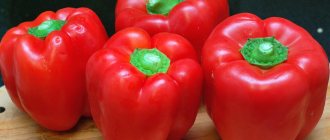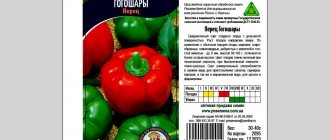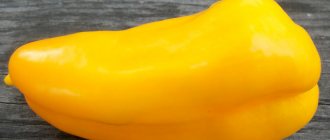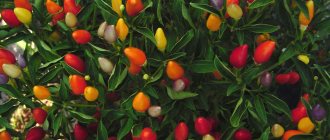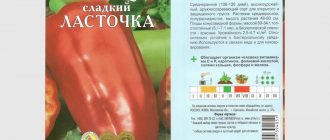Climate of the Urals
In the Ural region it is not always possible to grow and harvest pepper in a short time.
In the south of the Urals, summers are warm. The average temperature here is kept at +20°C. To the north, summers are much cooler. In some settlements, the thermometer in summer shows no higher than +15 degrees. Such conditions do not allow growing vegetables even in protected soil, since the bushes are deprived of light and heat. In the south of the Urals, warmth remains for 4-5 months. In the north of the region, the number of warm days suitable for growing vegetables is no more than 60. This is clearly not enough to form and achieve technical ripeness of pepper.
Advice! For growing in the Urals in open ground or in greenhouse conditions, pepper varieties with early ripening and good resistance to cold are more suitable.
Rules for choosing seed material wisely
Growing seedlings in the Ural conditions requires focusing on early ripening varieties. For more than 10 years, this vegetable has been successfully grown in the Ural lands, producing juicy and aromatic fruits.
When growing, special attention should be paid to compliance with all agrotechnical measures - sowing seeds, care. Experts recommend the following varieties adapted for the Urals:
- “Kolobok” is characterized by a small bush structure and a fruit weight of approximately 85 grams; this pepper is best grown in greenhouse conditions or in the ground.
- “Topolin” is distinguished by large fruits weighing 120 grams, red peppers have a sweet taste, and the bushes are tall and are often grown on trellises.
- “Firstborn of Siberia” is a mid-season variety with a stem height of up to 50 centimeters, the weight of the pepper is approximately 50 grams, and the colors can vary from red to yellow.
- “Sibiryak” is a mid-season pepper with a bush height of up to 50 centimeters and a fruit weight of about 120 grams; it is perfectly cultivated in heated and unheated greenhouses.
- “Montero” is an early ripening pepper about a meter high, the color of the fruit is bright red; in the conditions of the Urals it is grown in greenhouse conditions.
- “Merchant” is characterized by early ripening, the fruits are formed weighing about 65 grams.
- “Pioneer” is a pepper that takes approximately 120 days to ripen; the fruit weighs approximately 60 grams.
- "Winnie the Pooh" is an early ripening variety, the growing season is about 120 days, the peppers ripen at the same time, which makes them easier to collect.
- “Bogatyr” is a mid-season variety, this variety is considered the most adapted for cultivation on the soil of the Urals, the weight of the fruit is approximately 150 grams, and is best grown in greenhouses and soil.
- “Bull” is a mid-season variety, characterized by red and yellow colored fruits, weighing approximately 200 grams. For the climate of the Urals, this variety is the best among the above.
It should be noted that when growing sweet and bitter peppers, you need to draw a clear boundary and plant them in different greenhouses, since bitter peppers can cross-pollinate with sweet peppers and the taste will be completely lost, that is, the sweet pepper will not be sweet at all.
During the growing season, pepper requires the following temperatures:
- during the day +24 degrees Celsius;
- the night should provide temperatures between 28 and 20 degrees.
Important! It should be clearly remembered that sweet pepper is a heat-loving and light-loving plant that requires regular care (watering, loosening). When choosing varieties of peppers in the Urals, you need to clearly read the instructions and plant peppers so that the growing season is 90–130 days
When choosing varieties of peppers in the Urals, you need to clearly read the instructions and plant peppers so that the growing season is 90–130 days.
The best varieties of bell pepper for the Urals and Siberia
Due to the cool climate, early-ripening and cold-resistant peppers are used for planting in the Urals. More often, varieties bred for greenhouse conditions are grown here. In smaller quantities there are varieties created for unprotected soil. To get a good pepper harvest, the plants are transplanted into permanent beds on time, providing them with additional insulation.
Pepper varieties for planting in a greenhouse
Varieties obtained for cultivation in film or polycarbonate shelters are not grown in unprotected beds. In the Ural region, in conditions of unprotected soil, their yield is greatly reduced. Sometimes they don’t have time to bear fruit at all. With timely planting and proper care, greenhouse peppers give a good harvest.
Yellow bull
A hybrid variety intended for cultivation in the Siberian region. It produces large, thick-walled fruits with a pleasant pulp taste. The average weight of the “Yellow Bull” pepper is 400 g. The pods with tender, fleshy pulp have a sweetish taste. When ripe, the color of the fruit changes from green to golden.
Cockatoo
The plant produces elongated fruits with red flesh. Tall bushes of the “Kakadu” variety are suitable for growing in greenhouses made of polycarbonate or glass. To obtain a timely harvest, plants need a large amount of light. When the conditions necessary for fruiting are created and proper care is taken, it takes up to 130 days for the crop to ripen.
Red Bull
Many vegetable growers call this pepper giant because of the huge size of the fruit. As they ripen, the color of the pods changes from green to dark red. The length of the fruit is 20 cm. Several chambers with a small number of seeds are formed inside each pod. The fruits have moderately dense pulp. The wall thickness is on average 1 cm.
Casablanca
After the bushes are planted in a permanent place, the fruit ripening period is 95 days. In the southern part of the Ural region, where the climate is more favorable, Casablanca peppers can be grown in unprotected beds. The variety produces large peppers with juicy pulp. The wall thickness on them is up to 6 mm. The “Casablanca” variety is very productive.
Claudio
A hybrid variety of bell pepper with a short fruit ripening period. The collection of ripe pods begins 72 days after sowing. As peppers ripen, they take on a red hue. The fruits have excellent taste, thin skin and juicy pulp. The wall thickness is 7 mm. Several chambers are formed inside the pod. Pepper “Claudio” forms tall, highly branched bushes.
Pepper varieties for planting in open ground
Sweet peppers are cultivated in unprotected beds only in the southern part of the Ural region. Seedlings can be planted only after warm weather has finally established itself, when the threat of return frosts has passed. The harvest in open ground ripens slowly. The number of fruits obtained from one bush is less than that of plants in greenhouses. Their advantage is resistance to viral and fungal diseases and low temperatures.
Veselinka
The variety was bred specifically for cultivation in the Siberian region. The bush reaches medium size in height and produces a small amount of fruit. Its yield does not exceed 3 kg per 1 m². As they ripen, the color of the pods changes from green to orange. The fruits are small in size. Their weight does not exceed 80 g.
Novosibirsk
Pepper is unpretentious to growing conditions. It has good productivity. With good care and suitable conditions, the yield of the Novosibirsk variety reaches 10 kg per 1 m² of planting. The cylindrical pods become red as they ripen. The pulp has a pleasant taste without bitterness and a bright aroma.
Sultan
A variety with a long growing season. Therefore, it needs to be planted early. The fruits reach full ripeness 165 days after sowing; harvesting can begin a month earlier. The bushes are low-growing, their height does not exceed 50 cm. Vegetable growers are attracted by large pods, the weight of which reaches 200 g.
Triton
The variety is unpretentious to growing conditions. Therefore, even in the cool Ural climate, obtaining a harvest of Triton pepper is not difficult. Bushes of this variety are not very tall. Their height does not exceed 50 cm. Medium-sized fruits ripen early. The variety has good yield.
Determining the timing of sowing seeds
The sharply continental climate of the Urals requires special conditions for growing peppers; they are mainly grown in an area under a film cover or in a greenhouse. Seedlings are planted in open ground around May 25–30. Despite the harsh climate of the Urals, peppers manage to ripen and delight vegetable growers with rich harvests of ripe and juicy pepper fruits.
Seeds sown during these periods in the future fit into all terms and produce a harvest 100 days after planting in open ground or in a greenhouse.
The harsh conditions of the Urals characterize the appearance of fruits at a time when the southern regions of Russia are already completely saturated with greenery and begin to prepare for the winter. Failure to comply with the timing of sowing pepper seeds can lead to 2 negative reasons:
- Pulling out sprouts.
- Delayed ripening of pepper fruits.
Short summers and lack of heat allow residents of the Urals to grow peppers only in greenhouse conditions. The seeds should be sown in such a way that the period from sowing the seeds to the ripening of the fruit is about 120 days, plus about 2 weeks for the time for the seedlings to sprout and get stronger.
The 2022 lunar calendar for the Ural lands determines the next date for sowing seeds for seedlings - February 20. The optimal timing is:
- On February 14–16, you need to sow sweet pepper seeds;
- 16–18 – sowing seeds of bitter pepper;
- On February 23, it is possible to sow sweet pepper seeds.
Important! From February 19 to 22 are unfavorable days for sowing, that is, during these periods you should refrain from sowing. If you did not have time to sow pepper seeds in February, then planting pepper in the Urals according to the lunar calendar 2022, you can sow them in March without any problems
The timing allows you to get strong seedlings; the following days are considered favorable:
If you did not have time to sow pepper seeds in February, then planting pepper in the Urals according to the lunar calendar 2022, you can sow them in March without any problems. The timing allows you to get strong seedlings; the following days are considered favorable:
- from 3 to 5;
- from 6 to 14;
- from 30 to 31 March.
There are cases beyond our control when a person does not have time to sow seeds either in February or March, then you should pay attention to the April sowing dates. To get strong seedlings, you should hurry up and strictly follow all the rules for sowing and caring for sprouts
In April 2022, the following dates are perfect: from April 9 to 12 on the rising moon, from April 24 to 25 and on the 30th.
People who plant seeds according to the lunar calendar have long preferred these dates and as a result receive a large harvest of juicy, brightly colored fruits.
Growing seedlings
In the Urals, peppers are grown in seedlings, regardless of where the plants will then be planted, in a greenhouse or in open beds. Seedlings are planted at the age of 60 days. It takes another 2 weeks for the seeds to germinate. The sowing time is calculated taking into account the time of transplanting the seedlings to a permanent place. Warming up of the soil to +18 degrees is considered a suitable condition for replanting. The night air temperature at this time should be at least +15 degrees. Such conditions are created in the Urals at the end of May.
Important!
Seeds for growing seedlings are sown in early March. If you plan to plant in a greenhouse, seeds for seedlings are sown at the end of February.
Seed preparation
Pepper seeds take a long time to germinate. Therefore, pre-sowing treatment is mandatory for them. First, the seed material is checked for germination. To do this, prepare a salty solution from 1 liter of water and 1 tbsp. l table salt. The seeds are dipped into the liquid and mixed thoroughly to eliminate air bubbles. After some time, most of the seeds sink to the bottom, and some remain floating on the surface. They are empty and will not sprout, so they are thrown away.
The remaining high-quality seeds are soaked in a weak solution of potassium permanganate for disinfection for 30 minutes. Then for another 20 minutes place in a mixture of 1 liter of warm water and 1 tbsp. l. wood ash to speed up germination. Instead of an ash solution, you can use any growth stimulator.
If store-bought seeds are used for sowing, they do not need pre-sowing treatment. Typically, industrially produced seed material is prepared in advance for sowing, disinfected and treated with stimulants. Such seeds are simply heated for several days by placing them in a warm place with a temperature of +25 degrees.
Soil preparation and sowing
To grow and care for seedlings, many vegetable growers use ready-made soil mixture for vegetable crops, purchased at a gardening store. If this is not possible, the soil is mixed independently from the following components:
- 2 parts humus;
- 1 part garden soil;
- 1 part sand.
For every 10 liters of prepared soil mixture, add 1 cup of wood ash. Pepper seedlings do not like transplants. Therefore, for more active growth, seeds are sown in individual peat or plastic cups. Several holes are made at the bottom of the containers to drain excess liquid and filled with prepared soil.
Place 2 seeds in each cup, deepening them by 1.5 cm. After germination, weak specimens are removed, leaving the strongest to grow. After planting the seeds, moisten the soil surface with warm water from a spray bottle and cover with film. The containers are left in a warm place with a temperature of +25 degrees. When shoots appear, the shelter is removed.
Seedling care
To obtain healthy and strong seedlings, pepper seedlings must be properly cared for and created favorable conditions for growth. Therefore, during the day the seedlings are kept at a temperature of +25 degrees. In the dark, they are transferred to a cooler room, where the air warms up to +15 degrees. This will help the seedlings quickly adapt after transplanting to a permanent location.
Important!
Plants are protected from drafts, but are regularly ventilated so as not to create conditions for the development of fungal diseases.
The soil in seedling containers must be constantly moist. Therefore, the seedlings are watered regularly. Irrigation is carried out as needed in the morning or evening. For irrigation, use settled water heated to a temperature of +25 degrees. The soil is moistened carefully by watering from a pipette or spraying with a spray bottle. Additionally, to reduce dryness, spray the air around the seedlings.
Leaves on seedlings appear 7-10 days after germination. After the formation of the third leaf, the first fertilizing with nitrogen is carried out to stimulate growth. To do this, use a solution of 10 liters of warm water and 1 tbsp. l. urea. Additionally, a little wood ash is scattered over the surface of the soil. The second feeding is carried out before transplanting to a permanent place. Use the same solution as a top dressing, adding 1 tbsp. l. superphosphate. Adherents of organic farming feed the seedlings with nettle infusion.
Before transplanting to a permanent location, the seedlings are hardened off. 2 weeks before the scheduled date, first open the window for several hours in the room where the seedling boxes are located. A few days later, during the day, the seedlings are taken out onto the balcony, shaded from the sun. If the air temperature does not drop below +15 degrees, the seedlings are left there overnight.
Azyktandyru
Tusіrіlіmnen kejin ekі apta otkende, men kus sanıraukułakpen (10 liters of sudha túyırshіktі құйылған з з з з з з liters) ірінші ret koshet.
Keyings turakty aralyktarda 10-12 kun (ammonium nitrates 15-20 g, superphosphate 30-40 g, potassium sulfates nemes keshendi tynaytyshtar 25 L su 30-50 g 70-10 g) zhumsides. Tamshylatyp zhatkan kezende, men azdap tynaytkyshtardyn dozasyn zhaksartuga zhane guldi asіruge mүmkindik beremin, al zhemіsterdi kalyptastyru kezinde kobіrek phosphor beredi.
Zhaksy osus men guldenu ushin, men keide qyzanak pen burysh ushіn tyңaytyshtar bekіnіsіmen osіmdіkterdi tamaktandyryp, aptasynan keyin — at kauchynynyn Kaury nemese Bucephal us concentrationson kuyynyz.
Burysh topyraktyn shekteulі molsherinde osіp kele zhatkandyktan, zhemіs-zhidektіn zhoghargy shіrіmіnіn aldyn aldyn alu ushіn men calcium nitrates erіtіnіnіsіmen X-NU MX tosemіnѣ ustіngѣgі bolіshterіn otkіzemіn. Biohummen tamaktandyru artyk bolmaidy.
Transplantation into open ground
The bed for growing peppers is arranged in a well-lit place, protected from the cold wind. At the same time, the rules of crop rotation are taken into account. You cannot grow peppers where nightshade crops used to grow. The best predecessors for vegetables will be legumes, melons, onions, and garlic.
It may be interesting Why the leaves of peppers turned white after planting in a greenhouse or open ground: prevention, treatment methods How to properly use calcium nitrate to feed peppers Peculiarities of transplanting strawberries into the garden bed in August
Work on preparing the beds begins in the fall and is carried out in several stages:
- dig up the area well, adding complex fertilizers containing potassium and phosphorus;
- in the spring, re-digging is carried out, adding ammonium nitrate;
- A few days before transplanting, water the bed with a solution of copper sulfate for disinfection.
In the Urals, it is recommended to plant peppers in warm beds. To do this, the selected place is covered with dark polyethylene to speed up the warming of the soil. Then lay the humus and pour it with a hot solution of urea from 10 liters of water and 1 tbsp. l. fertilizers Cover the bed with film again for several days. Before planting plants, lay a layer of fertile soil fertilized with wood ash, more than 10 cm thick.
Preparatory work for seed material
Before sowing, pepper seed material should be checked for germination, and for this they are soaked in water at room temperature or in a weak saline solution. Full-grained seeds will remain at the bottom, and empty ones will float to the surface, that is, the seeds that are at the bottom are to be sown. To stimulate germination, the following activities should be carried out:
- pour warm water over it and leave for about 20 minutes, then put in a cool place, for example, in the refrigerator for a day;
- treat pepper seeds with a solution of a biological growth stimulator - “Zircon” or “Epin”.
Some vegetable growers plant seeds directly into the soil, while others germinate them first. Sprouts from sprouted seeds produce more friendly and strong shoots.
The following methods are used to disinfect seeds:
- pour the seeds with a weak solution of wood ash, such a solution will get rid of pathogenic microbes and be saturated with nutrients;
- warm the seed material in hot water. It is worth noting, not in boiled water, but in hot water at a temperature of 55 degrees Celsius for 30 minutes;
- warming up the seeds with a dry warm air stream, possibly carrying out this event in the oven;
- Soak the pepper seeds in onion peels; to do this, add a handful of peels to one liter of water, and soak the seeds for 3 hours.
Experienced vegetable growers often use the following recipes:
- Dissolve a teaspoon of honey in a glass of water and soak the seeds for 1 hour;
- aloe flower juice, for soaking, aloe leaves are kept in the refrigerator for a week, then the juice is squeezed out, diluted with water in a ratio of 1:3 and the seeds are soaked.
Transplanting into a greenhouse
The seedlings are transplanted into the greenhouse in late May. The soil is prepared in advance by digging and fertilizing. A few days before planting, the soil is disinfected by spilling a solution of copper sulfate.
Holes for seedlings are made at a distance of 45 cm from each other for tall varieties. For peppers with medium-sized bushes, 35 cm between individual plants is sufficient. An interval of 70 cm is left between the rows. This way, all plants will have enough sun and air. The plantings are not thickened so as not to provoke the development of infection and the spread of insects. Before planting, pour 2 liters of warm water into each hole and add 1 tbsp. l. wood ash. The bushes are carefully removed from the cups and placed in the prepared holes without deepening them. The free space is filled with soil and compacted at the stem.
The danger of frost in the Ural region remains until mid-June. Therefore, even in greenhouses, vegetable growers arrange temporary shelters for young plants. To do this, arcs are installed over the seedlings and spunbond is stretched. In sunny and warm weather it is removed, but returned to its place at night. The shelter is finally removed in the second half of June.
Preparing warm beds
The area for peppers is prepared in advance. In the garden, select a sunny area, protected from cold winds, where legumes, cruciferous or pumpkin crops previously grew. Nightshades are bad predecessors for peppers. In the greenhouse, the soil is enriched with complex mineral fertilizers, laying them in granular form during digging.
Both in open and protected ground in the Urals, warm beds with a width of 70 cm are prepared in the fall, using rotted manure as “biofuel”. Row spacing – 80 cm. Basic steps:
- Remove a half-meter layer of soil.
- A 20 cm layer of drainage material is placed at the bottom, which is covered with manure (thickness - 30-40 cm).
- The removed soil is returned from above.
Care
Peppers are watered frequently, but only a small amount of water is used for irrigation. In hot weather, up to 3 liters of water are consumed per plant. If the temperature is moderate, 1.5-2 liters of liquid is enough. Irrigation is carried out in the morning or evening, when there are no bright rays of the sun, only with warm, settled water. The liquid is poured under the root, preventing moisture from getting on the leaves. When the time comes for fruit ripening, the intervals between irrigations are increased to 3-4 days.
To reduce the number of waterings, loosening is used. The procedure is useful for improving the air supply to the root system. It also promotes more complete absorption of microelements dissolved in the soil. The first time the soil is loosened a week after replanting, after watering. At this time, the plants will already have time to take root and begin to grow. The soil is loosened shallowly so as not to damage the root system.
Important!
There is no need to loosen the soil if the surface layer of soil is covered with mulch. The protective layer improves aeration of the root system and prevents the formation of crust after watering.
To get a good harvest, be sure to carry out several feedings:
- For the first time, the peppers are fed with organic matter. The working solution is made from mullein, diluting it with water in a ratio of 1:10, or from bird droppings. In the second case, the solution concentration is 1:20.
- The second time, fertilizers are applied shortly before flowering. Feeding is needed to stimulate the formation of ovaries. This time, a mineral complex with a high content of potassium and phosphorus is used as a fertilizer. The solution is prepared according to the instructions for the drug.
- The third feeding is carried out during fruiting. For it, a solution of mullein is used in combination with potash fertilizers.
For highly branching tall varieties of pepper, it is necessary to form a bush with the removal of stepsons. Varieties with small bushes usually do not need this procedure. Stepchildren are cut with disinfected scissors, immediately sprinkling the cut with charcoal to prevent possible infection. The work is performed during the day in hot weather. Then the exposed areas will dry out quickly.
When forming, non-fruit-bearing, damaged branches or those directed inward are cut off from pepper bushes. After the ovaries appear, all lower shoots located under the branches with fruits are removed. Pruning is carried out every week, removing excess branches. At the beginning of August, the growing point is pinched to stop the growth of the bush. Then all the inflorescences are cut off, since they will no longer have time to produce full fruits.
Features of agricultural technology
Basic care techniques - standard
The success of cultivation and the overall yield of a crop is largely determined by the quality of the seedlings, so it is very important to sow the seeds on time and grow strong, healthy seedlings
Sowing dates and growing seedlings
Peppers are plants with a long growing season. In regions of temperate and harsh climates, seeds are sown early using the seedling method of cultivation. Usually - mid or late February, and it is recommended to take seeds of early or mid-season hybrids and varieties.
Main preparatory activities:
- sorting;
- soaking for disinfection in a solution of potassium permanganate (up to 15-20 minutes);
- germination in tissue (seeds swell within 12-16 hours);
- sowing.
They practice sowing immediately into separate containers (cups, pots), as well as into general containers and boxes. The soil is prepared in advance using store-bought soil mixtures or those prepared with your own hands. The soil for seedlings should be loose and fertile.
Note! Ready-made peat mixtures are not suitable for sowing sweet peppers. They need to be mixed with turf soil, calcined river sand, and ash (2:2:1:0.5). From fertilizers, add ash, potassium sulfate, superphosphate, ammonium nitrate (15 g of additives per bucket of soil).
Peppers do not tolerate diving well, so more often the seeds are sown immediately in separate containers, adding soil to the seedlings as they grow. The temperature before the sprouts appear is at least +24ºC, after the sprouts appear, it is reduced to +18ºC... +20ºC. This is done so that the seedlings do not stretch
After about 4-5 days, stable values of +22ºC…+24ºC are established
This is done to prevent the seedlings from stretching out. After about 4-5 days, stable values of +22ºC…+24ºC are established.
When planting in common boxes, they dive when 2-3 true leaves appear. It is advisable to plant with a clod of earth to eliminate the risk of damage to the roots of the seedlings. For peppers, they provide long daylight hours (13-14 hours) by installing phytolamps or LED lamps near the seedlings. Fluorescent lamps that are suspended above the seedlings are suitable.
Water the seedlings in the morning with warm, settled water. It is convenient to moisten the soil with a spray bottle, while avoiding getting moisture on the leaves and shoots of the pepper. To prevent blackleg, it is advisable to water the seedlings 1-2 times with a solution of potassium permanganate (the concentration is slightly pink).
Feeding - 2-3 times, after watering. They use ready-made complex compositions for seedlings (Kemira, Agricola), multicomponent fertilizers containing micro- and macroelements necessary for the crop.
Approximate schedule:
- The first application of fertilizers is 12-14 days after picking or the formation of the first true leaf. Dilute a tablespoon of urea in 10 liters of water and feed the seedlings;
- the second time - after 10 days, diluted with superphosphate (the proportions are the same as for the first feeding with urea);
- the third time - if necessary, with infusion of ash or superphosphate.
14-16 days before the expected planting of peppers in the Urals, seedlings begin to accustom the seedlings to new conditions. The seedlings are taken out into the fresh air: onto the balcony, loggia, or veranda. The first days, the duration of hardening is 20-30 minutes, then the time is gradually increased, and on warm days the peppers are left in the open air for the whole day.
Preparing the beds
The soil is prepared in the fall, given that the crop loves fertile, well-drained soils. It is recommended to plant plants in soils with neutral acidity, pH 6-6.6. Plants are sensitive to excess nitrogen, so fresh manure cannot be applied.
Note! Excessive amounts of nitrogen fertilizers in the soil leads to intensive growth of green mass, “fattening” the bushes to the detriment of fruiting.
Recommended compositions (applied in the fall):
- humus – 5-10 kg (depending on the type of soil);
- superphosphate – 60 g;
- potassium supplements - 25 g.
The standards are given per square meter of plantings. You cannot plant the crop after any plants of the Solanaceae family. Close proximity to potatoes and tomatoes is also undesirable. Do not plant sweet and spicy varieties together, as cross-pollination is possible, and the fruits of the first type will be bitter.
Diseases and pests
When grown in the Ural region, the greatest danger to peppers is aphids and spider mites. Of the infectious diseases, peppers most often suffer from white and gray rot.
To cope with insects, preventive treatment of pepper bushes is carried out using folk remedies:
- soap-ash solution;
- tobacco infusion;
- decoction of onion peels.
If pests have already appeared, use more effective means. At the stage of active growth before flowering and fruiting, insecticide preparations give good results. Plantings are sprayed with the drug “Actellik” or other means of similar action. In a later period, it is undesirable to use chemical insecticides. Therefore, biological agents are used, for example, Fitoverm.
Pepper diseases most often develop due to high humidity and dense planting. Therefore, when growing in greenhouses, it is necessary to regularly ventilate the room. Be sure to follow the watering schedule without flooding the plants. The soil under pepper bushes should be moist, but not wet. The situation can be corrected by temporarily stopping watering and organizing good drainage. If suspicious spots and other signs of disease have already appeared on the plants, the bushes are treated with solutions of biological fungicides.
Harvesting
Pepper fruits do not need to be harvested when fully ripe. They can be consumed after reaching technical ripeness, when they have reached their maximum size, but have not yet changed color. At the ripening stage, pepper bushes do not form new ovaries. If the pods are not removed at the right time, the yield is reduced.
After harvesting, the fruits will gain color within 7 days. To do this, they are placed in a dark place and maintained at +20°C. At lower temperatures, pods ripen within a month.
Important!
Peppers are harvested in dry weather. High humidity causes fruit to rot. To separate the pod, it is cut with a knife or pruning shears. Attempts to break off the fruit lead to damage to the stem.
Reviews
Inna, 38 years old:
I constantly grow peppers in a greenhouse. Greenhouse conditions make it possible to successfully grow even mid-season varieties, although our climate in the Urals is not favorable for growing vegetables. To get a good harvest, I plant the bushes at a distance from each other and constantly monitor them so that no signs of disease appear.
Zhanna, 45 years old:
In cool climates it is better to grow early varieties. They have time to ripen even with a short summer. To protect the planted seedlings from frost, we cover them with spunbond after planting. Then the plants successfully survive frosts.
To successfully grow peppers in cool climates, the plants need careful care. Seedlings are transplanted to a permanent place only after warm weather has established and are protected from possible frosts. If you follow all the rules of agricultural technology, you can get a good harvest of vegetables even in an unfavorable climate.
Planting scheme
The distance at which peppers should be planted will depend on the variety. Information on optimal plant placement is provided on the certified seed package, but there is also a standard layout that can be followed. In a row, plants are placed 40-50 cm apart from each other, and 60-70 cm of space is left between rows. According to this scheme, you can plant bushes of normal height and large-fruited ones. For low-growing varieties of the crop, the planting scheme for pepper seedlings may be different. They can be placed more densely (30 cm in a row by 40-50 cm in row spacing). This distance is sufficient for varieties with medium-sized fruits. Another benefit of close planting is that the pepper leaves can better protect the fruit from sunburn. Its disadvantages: it is difficult to water and loosen, process bushes and collect fruits.

